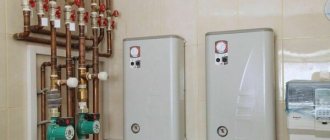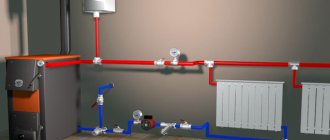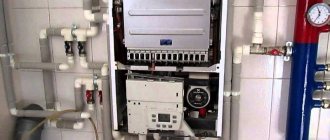Gas boilers have reliably taken their place among efficient, economical and energy-independent heating devices. The history of their use as a means for heating domestic premises, from the development of the design to the modification of the latest generation, goes back about 100 years. The difference between modern devices and old-style devices is visually and technically noticeable and manifests itself in terms of power, durability, and external aesthetics.
They differ:
- the boilers are old, characterized by a primitive design;
- ultra-modern gas appliances equipped with energy-saving automation of the latest developments;
- modified, combining the developments of old years with new technologies.
Old boiler
Old gas heating boilers: types, features, nuances of installation and operation
Gas boilers have reliably taken their place among efficient, economical and energy-independent heating devices. The history of their use as a means for heating domestic premises, from the development of the design to the modification of the latest generation, goes back about 100 years. The difference between modern devices and old-style devices is visually and technically noticeable and manifests itself in terms of power, durability, and external aesthetics.
The best Russian floor-standing single-circuit boilers
Let's look at the most popular models of Russian floor-standing gas boilers:
Lemax Premium-20
Products of the plant of the same name from Taganrog. A non-volatile floor-standing boiler with a power of 20 kW is capable of heating a house of 200 square meters. m.
Its main characteristics:
- Efficiency - 90%;
- coolant temperature (max) - 90°;
- heating system pressure (max) - 3 Bar;
- fuel consumption - 2.4 m3/hour;
- dimensions - 556x961x470 mm;
- weight - 78 kg.
The high demand for Lemax boilers indicates the demand and positive attitude of users towards domestic heating units.
Types of modern gas boilers and their comparative characteristics with old models
Manufacturers produce about 1000 models of boilers, which differ in physical and technical characteristics, materials of manufacture, functions and design. Photos of their design options, from shapes and colors to installation methods, serve as further confirmation of the diversity of these devices.
Gas heating boilers are divided into:
The design of the boilers allows heating rooms of any size, maintaining the heating temperature of the boiler at the same level (if the heating boiler is of a combined type with additional heating elements). You don’t have to monitor the burning of the flame - this is done automatically.
At the same time, old-style boilers could not, even at the peak of their popularity, at the time of release from the conveyor belt, boast such a variety. They were produced only in a floor-standing version and did not allow precise regulation of the heating temperature of the coolant: it was necessary to manually reduce or increase the burning power of the flame and ensure that the gas supply did not stop.
Today, controlling heating appliances has become more economical and comfortable, but the models of previous years provided a reliable basis for the production of modern boilers.
Old boiler AGV-80
Basic elements of automation
The main elements of automation for a gas boiler are:
- thermostat;
- shut-off valve;
- traction sensor;
- flame sensor;
- igniter tube;
- igniter;
- burners.
Let's try to clearly explain how automation for a gas boiler works, breaking it down into its main elements and talking about their functions.
The gas passes through a gas purification filter. Next it goes to the solenoid valve, which regulates the fuel supply to the burner. Temperature and draft sensors are located next to the valve, monitoring the indicators and signaling if they exceed acceptable standards. Also, the automation kit for gas boilers includes a thermostat with a bellows and a rod, designed to set the desired temperature. A special button is used to adjust the indicators. When the water is heated to the temperature set by the user, the thermostat is activated, the gas supply to the burner is stopped, while the igniter continues to operate. When the water cools by 10-15 degrees, the gas supply is resumed. The burner lights up from the igniter. The automation is started manually.
An example of a retro boiler - AGV-80 and modifications
AGV-80, the photo of which is shown above, belongs to the old type of heating boilers. It has one circuit (heating water for domestic needs). Production of the model began in 1939 at the Zhukovsky Machine-Building Plant. The reason for this was the mass gasification in the USSR and the use of gas for heating domestic premises.
The boiler is a cylinder on three legs, in the upper part of which there is a chimney pipe. The cylindrical tank is made of steel, sealed, with a volume of 80 l. Inside the tank is a flame tube, under the mouth of which an atmospheric burner is installed. To reduce the speed of heated gases escaping into the pipe and increase the degree of heating of the tank walls, a turbulator is mounted inside the pipe. The efficiency of the device reaches 80%.
When the pressure drops or the maximum water temperature reaches, these devices allow you to shut off the gas supply.
The design of this boiler served as the basis for the company's developers to produce improved models AOGV (for CO) and AKGV (with two circuits), the efficiency of which is up to 89%.
In addition to a similar design, the new generation gas boilers include:
Construction of the AVG-80 boiler
Operating principle
The operation of a single-circuit floor-standing gas boiler consists of flow-through heating of the coolant using thermal energy obtained from fuel combustion.
The liquid enters the heat exchanger, receives the maximum possible heating for a given operating mode and enters a three-way valve . This is a unit where the hot coolant is mixed in a given proportion with the colder return flow.
The more return is added, the lower the temperature of the liquid entering the heating circuit. This is how the room heating mode is adjusted. The coolant moves under the action of a circulation pump, and the air supply and smoke removal are controlled by a turbofan.
The operation of all components is under continuous monitoring of a self-diagnosis system - a network of sensors installed on important components and parts of the boiler.
If abnormal situations occur or any elements fail, the sensors signal to the electronic control board, which immediately generates an error signal.
Some types of malfunctions cause immediate shutdown and blocking of the boiler for safety purposes; the control unit simply notifies the user about minor malfunctions.
Nuances of maintenance and connection
Now, as before, installing a gas heating boiler is not an easy task. To install such equipment you will need:
A number of norms and rules have been developed that will have to be followed during installation:
Gas boilers of the old type were connected to chimneys at least 5 m long, only with natural draft. These requirements were mandatory and contributed to minimal formation of condensation - the main drawback of retro devices.
Now coaxial chimneys and circulation pumps are used, so it is possible to provide forced draft and install the chimney through a wall or into a ventilation shaft, which makes installation easier and makes the chimney connection area neater. The photo shows the correct installation of the boiler.
Wall mounted boiler
The market now offers installation components and care products that extend the life of devices and increase operating efficiency.
The compact design of the new heating devices and light weight, which are especially distinguished by wall-mounted gas models, allow the device to be installed in a matter of hours, as shown in the video below, and used even in small rooms.
Criterias of choice
Now that we’ve sorted out the basic concepts, it’s time to voice additional criteria that will help evaluate the ease of use of the models you’re interested in and add individuality to them.
External insulation available. It is the external thermal insulation that makes it possible to reduce heat loss when warming the boiler room and significantly slows down the cooling time of the boiler. This also allows you to load the firebox no earlier than after 7-12 hours, eliminating the need for “cold” kindling.
The number of elbows in the smoke exhaust system. If the boiler chimney is straight, its performance is equal to the efficiency of a small indoor fireplace. The more economical the heating device becomes, the more parts the chimney is made of.
Pressurization system. The presence of such a unit reduces the requirements for the number of chimney bends. At the same time, a boiler with high efficiency copes well with the process, even with clearly weak draft. Devices with a pressurized design require constant monitoring of the furnace door seals; the presence of the most inconspicuous gap guarantees the entry of smoke into the living areas of the house.
Features of operation
The boiler was produced, naturally, at factories in the USSR, made from domestic raw materials and equipped with locally produced electronics. The quality of workmanship was at a high level, but the automation failed in the vast majority of cases already in the first heating season. But the equipment worked perfectly without it, so no one paid attention to such a defect.
But the boiler was reliable and durable in all other respects. The level of gas consumption was indeed incredibly low, although the efficiency barely reached 70%, which is an extremely low figure for gas installations. But still, for private houses this was the only way to heat a home using a modern unit, and not an old wood- or coal-burning stove. And in multi-storey buildings, such a boiler made it possible to improve living conditions, since residents could regulate the temperature of the interior themselves.
The factory glass thermometer also quickly failed and had to be replaced with a higher quality product. But for repairs it was possible to use parts from any other equipment. The main thing is that the size and shape are suitable, and craftsmen can figure out how to fit them in place without any problems. In general, the model had an incredible number of user modifications.
Types of solid fuel equipment
Boilers are classified based on their functionality, materials used and combustion principles.
Depending on the material of manufacture, there are two types of solid fuel boilers.
- Steel units are lightweight and affordable.
- Cast iron models are heavier and larger, but their service life is much longer. They are practically not subject to corrosion, are durable and can withstand high temperatures.
According to its purpose, a solid fuel boiler can be single-circuit or double-circuit. The first is intended exclusively for heating rooms, the second, in addition to the heating function, also performs the function of heating water.
A solid fuel water boiler operates according to the classical scheme - fuel combustion occurs from the bottom up. Loading is carried out through the top door, and it is ignited below through the firebox window, which is also used to clean the unit.
Pyrolysis boilers are considered the safest and most durable. They are characterized by long-burning technology. In this regard, boilers have certain advantages: efficiency, high productivity, long-term operation on one load, and environmental friendliness.
Boiler design and functionality
The quality of Soviet products was in many ways superior to modern products from domestic factories. Therefore, the AGV 80 gas boiler is still in use in some homes. Most likely, everything that can be replaced has already been replaced, and only the body remains from the original product. Installing foreign components into the device can significantly increase its efficiency in accordance with current parameters for today.
A simple device allows for creativity. The boiler can be easily disassembled using a standard set of tools. Almost any devices can be attached to it, as long as they fit in the dimensions. Installing a heater and installing the entire system is no different from operations with modern devices. In the same way, it is necessary to provide direct and reverse water supply, gas supply and a chimney to remove combustion products. You can install a turbine that will draw smoke into the atmosphere.
Using Soviet technology was very easy. It had a small number of functions, and next to each button there was a large inscription by which you could navigate what this element was responsible for. The instructions for the AGV 80 gas boiler were included with the device. But she couldn’t tell anything fundamentally new.
It was only important to familiarize yourself with the connection diagram and read the section with safety precautions. Everything else could be figured out on your own within a few seconds. Nowadays, finding a paper version of the user manual will be very problematic, so you should use the Internet. Here you can easily find instructions for any type of equipment, regardless of the year of its manufacture.
The operating principle of such a boiler
The principle of direct operation is similar to boilers made from other materials or differs very slightly. To ensure the operation of such installations, conventional standard components are used.
The components of such a node are:
- burner;
- a pump that circulates the coolant;
- combustion chamber;
- heat exchanger
The boiler works because the supplied fuel, that is, gas, is burned in the combustion chamber and all the heat is supplied to the coolant coil. In cast iron boilers, the main element is the cast iron coil, which is responsible for ensuring that the coolant is heated evenly.
The positive principles of operation of cast iron gas boilers include:
- good corrosion resistance;
- wave-like heat transfer;
- good adaptation to severe thermal overloads;
- long service life;
- control maintenance is kept to a minimum.
But there are also disadvantages:
- significant weight;
- quite plastic, and therefore sensitive to loads that are produced mechanically;
- During critical thermal shocks, microcracks form.
Model overview
The AGV 120 gas boiler model differed only in its greater power. It had all the shortcomings of the basic device, so it cannot be called next-generation technology. Not the most successful internal design led to a situation where part of the received thermal energy flew out into the chimney along with combustion products. It was possible to eliminate this defect independently by changing the firebox design, but such a modification was associated with a certain risk. If the calculation was incorrect, it was possible to achieve an effect where the exhaust gases stopped being released into the atmosphere and remained directly in the room. In this case, the whole procedure had to be carried out again.
The AGV 23 gas boiler was a more successful modification. It did indeed eliminate some of the shortcomings, making it more ergonomic and easy to use. Among the main improvements it is necessary to note:
In general, AGV gas heating boilers were a very successful invention for their time. They allowed people to switch from solid fuel systems to more modern and convenient gas analogues. This was an important step towards the complete abandonment of environmentally harmful heaters. Now solid fuel models in everyday situations are used only in extreme cases. Most users switched to gas or electric systems.
The price of AGV gas boilers is negotiable. They have been discontinued for a long time, so you can only make a purchase on the secondary market.
Source
The most common automation malfunctions and methods for eliminating them
Before setting up the automation on the boiler, it is necessary to diagnose it. As a rule, serious malfunctions occur that will require specialist intervention. The adjustment can also be entrusted to a gas technician. Or you can do it yourself by reading the instruction manual.
Attention! Before each seasonal operation, it is necessary to check the operation of the safety sensors.
Most often, the filter becomes clogged, problems arise with the valves, sensors burn out due to power surges, and a gas leak is detected. Proper cleaning of the filter should be done by a professional. You can try to replace electronic elements yourself by carefully studying the operating instructions for your boiler.
In order to replace the temperature sensor, you need to turn off the gas boiler and cool the water to a temperature of 40 degrees. Shut off the flow of coolant, remove the control knob by unscrewing the screw. Next, remove the PTV adjustment screw. Remove the sensor bellows with the support washer. Unscrew the union nut of the sensor thermal bulb. Install the thermal bulb of a working sensor into the boiler jacket and screw it tightly. Install the sensor bellows into the pipe socket, install the support washer on the bellows, install the PTB adjustment screw and adjust the temperature.
If problems arise with igniting the igniter, then one of the possible causes is a malfunction of the draft sensor. In this case, it must be dismantled, diagnosed, checked contacts, cleaned, and, if necessary, replaced with a new one.
Also, common reasons why the pilot light does not light may be:
- gas valve malfunction;
- clogging of the hole in the igniter nozzle (it can be cleaned with wire);
- strong air draft;
- low gas inlet pressure.
When the gas supply is turned off, it is necessary to check the chimney (it may be clogged), the electromagnet, and the gas pressure at the inlet to the gas boiler.
Attention! To diagnose and repair the gas boiler automation, you must invite a specialist. Inept actions can aggravate the problem and lead to undesirable consequences.
For the automation of AGUK, AGU-T-M, AGU-P systems, the most common problem is the burnout of the bimetallic plate, which is used as a sensitive element.
In Arbat and Orion, you can only replace the thermocouple and draft sensor, as well as the solenoid valve (rarely). The automation unit is practically beyond repair. In Arbat, the system shutdown button often breaks down.
Typical problems for SABC automation are damage to the main valve membranes and drying out of the thermostat stuffing box, resulting in gas leakage. Impulse tubes, bimetallic plates, and ball valves are subject to control.
In conclusion, I would like to emphasize once again that automation is designed to maintain the operation of heating equipment in a safe mode. Therefore, it is simply necessary for owners of gas boilers.
This video shows how to troubleshoot an automatic boiler AOGV, step-by-step assembly process and testing the result.
Types of gas boilers and their differences
There are conditions without which a person’s daily life will not be considered fully comfortable.
First of all, these are various life systems, which include heating and a source of hot water in the premises.
The first designs that made it possible to effectively heat the interior spaces of buildings appeared during the Ancient Roman Empire.
Initially, solid fuel (wood, coal, etc.) was used for this process, but the development of civilization led to the possibility of using electricity, liquid fuel, solar energy, and natural gas for such purposes.
History of the development of gas boilers
The first mass production of gas equipment for heating water was established at the beginning of the 20th century in Germany.
The manufacturer became, which also used in its product an innovative technology at that time - an automatic control unit for the entire system.
The first domestic serial gas boiler appeared only in 1947. The model was produced under the name "Conord".
In world practice, the development of heating and water heating equipment depended on the availability of certain resources.
For example, in the USSR they mainly produced gas boilers, since the fuel for them was and remains very affordable.
In Europe, models powered by electricity were more valued.
Products that run on diesel fuel and, more recently, solar power have sold well in the United States.
What principles should you follow when choosing a boiler?
When choosing a boiler, a person must first of all be guided by the advantages or disadvantages of a particular model. Therefore, it is worth taking a closer look at what advantages or disadvantages cast iron gas boilers have:
- Cast iron heating devices are much more expensive than similar units made of steel. But this cost is justified by the fact that a cast iron device will last 15 years longer than a steel one;
- If a steel heat exchanger breaks down in a steel boiler, then any technical part cannot be repaired, because it is impossible to seal the seams by welding. But a cast iron unit can be repaired quite easily, because it is assembled in sections and any of the component parts can be replaced;
- if the user has some welding skills, then you can quite easily repair the boiler yourself, as well as increase the volume of the existing cast iron boiler by attaching sections;
- cast iron is difficult to corrode and is also inert to the effects of any acids, so any antifreeze can be safely poured into the circuit;
- Cast iron has much better thermal characteristics than steel.
There are not many disadvantages to such heating systems:
- high cost, due to the fact that cast iron is more expensive than steel, but this is offset by a long service life;
- heavy weight, it is quite difficult to install such a boiler alone;
- mandatory filling of the slab under the boiler itself.
Despite the fact that cast iron boilers are less popular than steel ones, the homeowner should still think about what to do better. Win a small amount on the difference in the cost of boilers at once, or still buy yourself a good unit so that it will serve for many years and also help save on fuel.
Varieties and types of gas boilers
Gas equipment is divided according to its functionality and installation location. In the first case, the boilers can be divided:
For wall mounting type.
For floor-mounted use.
Each of these types has its own characteristics that should be taken into account when choosing the required model.
Single-circuit gas boilers
The main feature of this option is that its purpose is only to work in a space heating system. If the owner of the model also wants to use the installed equipment as a source of hot water in the house, then he will have to incur additional financial expenses - he will need to buy a special boiler that can be connected to this gas boiler.
Double-circuit gas boilers
Such equipment, in addition to working in the heating system, is also a source of hot water. Naturally, a double-circuit boiler is more expensive than a single-circuit version, but it is almost always cheaper than a tandem consisting of a boiler and a single-circuit model.
However, it is worth noting that a double-circuit boiler has a number of disadvantages:
The greater the number of hot water consumers, the less efficient such equipment is (it is recommended to count on a maximum of three people who consume the heated liquid from the boiler). Consequently, in other situations, the installation of a boiler or other water heating equipment will still be required, which will lead to additional financial waste.
The further away the point of water consumption is, the longer it will take to wait for the liquid to reach an acceptable temperature. Typically, experts do not recommend placing consumer taps at a distance of more than 7 meters of pipe from the boiler. Exceeding this limit will lead to a fairly long wait, as well as wasted water that will have to be drained.
How to properly install equipment
You can install such equipment either independently or with the help of boiler installation specialists. The only condition that cannot be violated is to include the boiler in the gas system itself, because such work will have to be entrusted to a specialist. Moreover, such people must have special permits and certificates. If the homeowner violates this provision, then first of all, he will be disconnected from the system, and secondly, a very large fine will be imposed. But in order to independently connect a cast-iron gas boiler, you will still need construction skills.
Cast iron boilers have an impressive weight, so if you buy a mounted boiler, then an impressive frame must be mounted under it. Such equipment must be installed in the boiler room.
And such technical premises have special requirements:
- The ceiling height in the boiler room must be at least 3 meters, and the room must be at least 4 square meters. meters. These parameters are suitable for an average-capacity boiler, but the larger the boiler, the more space there should be around. Usually such things are recommended by the manufacturer themselves;
- the presence of at least a single window, because there must be air flow. The door opening must be 80 cm wide and the gap between the floor and the door leaf must be at least 35 mm;
- the distance to electrical and gas installations or appliances must be at least 3.5 meters;
- On the floor, in the place where the cast iron boiler is planned to be installed, a cement screed is poured, and this place is reinforced with a steel plate. It is important to remember that the steel sheet must be located under the entire surface of the bottom of the heating installation, and also protrude 3-4 cm beyond its front side;
- With materials that have fire-resistant qualities, it is necessary to strengthen the entire part of the wall where the chimney pipe will pass.
You might be interested >> Danko gas floor-mounted single-circuit boilers
The main document when independently preparing a boiler for mounting it into the system should be an accompanying document in the form of instructions developed by the manufacturer.
Such a document gives parameters and regulates the procedure for connecting the boiler to the main pipeline, to the chimney system, as well as to the return and supply systems.
Differences between different types of boilers
Gas boilers also differ in the type of burner and the method of removing combustion products.
Atmospheric. Natural air supply necessary for flame operation. Requires good ventilation in the premises. Characterized by the presence of an open combustion chamber.
Diffusion-kinetic. Something in between the first two types, when air is supplied to the combustion chamber in certain portions. A rather rare option in household equipment - usually used in industrial settings.
Combined. Allows you to use several types of fuel (gas, wood or fuel oil) without changing the burner. The versatility of the system has led to a number of disadvantages: lower efficiency, high cost, design complexity, which increases the time and cost of preventative and repair work.
According to the type of removal of combustion products, gas boilers are divided:
On a model with natural traction. The combustion products of gas boilers are lighter than air, which is why this fact is used in equipment with natural draft. To operate such models, you must have a special chimney with good air exhaust. Typically, such boilers are installed in private houses, where a riser for gas removal can be built separately.
For equipment with forced gas removal. These models are equipped with fans that forcefully remove combustion products from the boilers. Requires connection to an electrical network. Typically, such gas boilers are installed in apartments.
Flame and draft sensors
Flame and draft sensors work on this principle. The draft sensor reacts to deteriorating smoke draft and transmits an impulse to the control system. It is located in the smoke hood. Equipped with a plate made of an alloy of two metals: iron and nickel. When draft deteriorates, flue gases accumulate and heat the plate. It becomes deformed, the contacts open, and the flow of fuel into the combustion chamber stops. When the temperature decreases, the plate returns to its normal state.
The temperature sensor works on the same principle. When the water in the boiler heats above the set temperature, the lever mechanism is activated and the temperature regulator valve closes. The gas supply stops and the burners go out.
When the water cools, the sensor bellows contracts, the lever mechanism is activated, the temperature regulator valve opens, gas begins to flow, and the burners light up.
Advantages and disadvantages of gas boilers compared to boilers using other fuels
The main advantages of gas boilers:
Fuel (natural gas) is cheaper than using electricity, wood, coal or fuel oil for a similar process.
The efficiency of gas boilers is higher than that of analogues.
Higher cost of installation work. The owner of a gas boiler will need to collect additional documents and obtain permission from Gaztekhnadzor. Naturally, this requires a waste of time and additional money.
To ensure the safe operation of gas equipment, the installation of additional systems and structures will be required. This is, first of all, the installation of a chimney and gas alarm.
Requires a gas line in most cases. Equipment operating on bottled gas is not economically viable.
Specifications
Cast iron gas boilers are the most popular heating units, which, according to their technical characteristics, are most suitable for use in buildings intended for permanent residence.
The operating principle of all cast iron boilers operating on gas is built as follows: heat is released, which owes its appearance to the fact that the fuel is burned and the air is heated. In short, the next stage of work occurs, that is, when fuel such as gas enters the combustion chamber, it burns and transfers all the heat to the coolant.
Then the coolant, which circulates through the system in a closed loop, is supplied to the batteries and the room heats up - the batteries begin to give off heat.
The technical characteristics of gas boilers with a cast iron heat exchanger differ in that:
- such a device does not require constant operation, since the heat exchanger retains heat well, and the temperature sensor, detecting temperature fluctuations, does not perform manipulations that will start the boiler;
- One of the main parameters that dominates the technical characteristics is the durability of this type of material, even though the conditions may be extreme.










